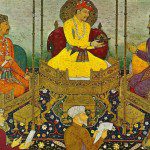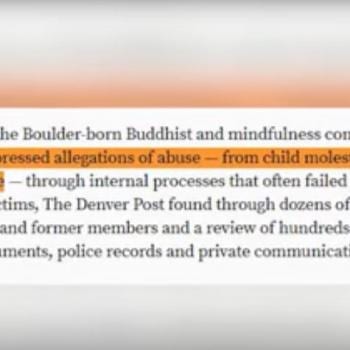In the Theragatha, or Poems of the Elders, the Buddha’s close friend, cousin, and attendant Ananda tells us that he has received 82,000 teachings from the Buddha and 2,000 more from his disciples for a total of 84,000. This great vastness of the Buddha’s body of teaching later became a metaphor for the many ways that Truth, Dharma, or simply ‘the teachings’ could come to a person.
In The Complete Book of Buddha’s Lists — Explained (available for free on google-books) David Snyder notes that “The 84,000 Dhamma doors are a metaphor to basically state that there are innumerable paths to enlightenment. This is a representative teaching to the Buddha‘s tolerance for other religions.”
And in this 21st century, it has also come to represent teachings from friendly felines and man’s best friend, as found here in an excerpt from Charles Prebish’s new book: A Puppy’s Path to Nirvana.
To understand the teachings of the historical Buddha for living beings, we first have to understand the way in which he saw and experienced the world. He called this view of the world the “Three Marks of Existence.” We prefer to call it the “World According to Puppies.” It argues for three basic principles. First, there is no permanent, abiding self. Second, the world is impermanent, changing all the time. And third, all life experiences what Buddha calls duḥkha, which his disciples translate as “suffering” (but as you’ll see later, we dogs describe quite differently).
To complicate matters, and unlike the beliefs of some other religions, Buddhism doesn’t believe in a permanent, abiding self or soul. To do so would contradict what we just learned above. So there is no self—what the Hindus call ātman—in Buddhism. For Buddhists, each individual is simply a conglomerate of five “aggregates:” form, feeling, perception, mental formations, and consciousness. We’ll explain these in another lesson. But there’s no permanent “Bill” or “Sallie” or even “Buddha” (although my family’s previous dog was called “Buddha the Beagle”). By not presuming each individual has some permanent and even holy self, there’s nothing to grasp after, and this helps to remove the basis for what Buddha later identifies as the cause of all suffering. So if there’s no permanent self, all you need to do is LET GO.
Humans have a hard time understanding the notion of impermanence. They try hard to grasp after things and experiences which they think they can make permanent, lasting. OK, it’s pretty hard to understand complicated notions like “quantum mechanics,” so we puppies can make the notion of impermanence much easier to grasp. We call this second mark of existence “The Road Runner Theorem.” Everyone—dogs and people alike—grew up watching the old “Roadrunner” cartoons. Poor old Wiley Coyote seems never to be able to capture and kill Roadrunner because all of his schemes rely on one basic principle: that Roadrunner will actually stop . . . and stop long enough to be crushed by a falling boulder or smashed by an oncoming truck. It just never happens because Roadrunner never stops moving. Equally, everything in our world never stops changing in each second, in each moment. So nothing—and we mean absolutely nothing—stays the same. Everything is continually changing and evolving. By the time I finish writing this sentence, I won’t be quite the same “Dharma Dog” that started the sentence. That’s why every important conversation we plan in advance always changes just a bit when it’s finally time to engage in it. The two beings involved keep changing, and what made sense two hours before just isn’t quite the same later. Sure it would be great to be able to retain the actual experience of the game-winning home run you hit during your freshman year of high school, or a great sexual romp with some hot partner you met in college, but you can’t. So don’t be dumb. DON’T TRY!
Finally, Buddha’s third mark of existence is his notion, which we’ll also explain more fully later, that all life is suffering. We’ll see that he doesn’t mean that every single moment is filled with suffering, but rather, when we can’t find permanence and ongoing satisfaction in every moment, we become unhappy with our existence, and engage in ongoing craving and grasping, which binds us more tightly into the endless cycle of rebirth. Buddha’s teachings help us learn to not only bypass suffering, but to completely eliminate it. That’s pretty easy too: start by GIVING UP CRAVING.
Now all we need to do is see how to do all this stuff.
Get this in .pdf form, and check out lesson 2.
Find out more at www.puppyspathtonirvana.com or www.facebook.com/













